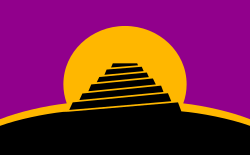Portal:Constructed languages
Introduction

A constructed language (shortened to conlang) is a language whose phonology, grammar, and vocabulary, instead of having developed naturally, are consciously devised for some purpose, which may include being devised for a work of fiction. A constructed language may also be referred to as an artificial, planned or invented language, or (in some cases) a fictional language. Planned languages (or engineered languages/engelangs) are languages that have been purposefully designed; they are the result of deliberate, controlling intervention and are thus of a form of language planning.
There are many possible reasons to create a constructed language, such as to ease human communication (see international auxiliary language and code); to give fiction or an associated constructed setting an added layer of realism; for experimentation in the fields of linguistics, cognitive science, and machine learning; for artistic creation; for fantasy role-playing games; and for language games. Some people may also make constructed languages as a hobby.
The expression planned language is sometimes used to indicate international auxiliary languages and other languages designed for actual use in human communication. Some prefer it to the adjective artificial, as this term may be perceived as pejorative. Outside Esperanto culture, the term language planning means the prescriptions given to a natural language to standardize it; in this regard, even a "natural language" may be artificial in some respects, meaning some of its words have been crafted by conscious decision. Prescriptive grammars, which date to ancient times for classical languages such as Latin and Sanskrit, are rule-based codifications of natural languages, such codifications being a middle ground between naïve natural selection and development of language and its explicit construction. The term glossopoeia is also used to mean language construction, particularly construction of artistic languages.
Conlang speakers are rare. For example, the Hungarian census of 2011 found 8,397 speakers of Esperanto, and the census of 2001 found 10 of Romanid, two each of Interlingua and Ido and one each of Idiom Neutral and Mundolinco. The Russian census of 2010 found that in Russia there were about 992 speakers of Esperanto (on place 120) and nine of the Esperantido Ido. (Full article...)
Selected language

Solresol (Solfège: Sol-Re-Sol) is a constructed language devised by François Sudre, beginning in 1827. His major book on it, Langue musicale universelle, was published after his death in 1866, though he had already been publicizing it for some years. Solresol enjoyed a brief spell of popularity, reaching its pinnacle with Boleslas Gajewski's 1902 posthumous publication of Grammaire du Solresol. An ISO 639-3 language code has been requested as of 28 July 2017.
The teaching of sign languages to the deaf was discouraged between 1880 and 1991 in France, contributing to Solresol's descent into obscurity. After a few years of popularity, Solresol nearly vanished in the face of more successful languages, such as Volapük and Esperanto. Today, there exist small communities of Solresol enthusiasts scattered across the world, able to communicate with one another due to the internet.
Solresol words are made from one to five syllables or notes. Each of these may be one of only seven basic phonemes, which may in turn be accented or lengthened. There is another phoneme, silence, which is used to separate words: words cannot be run together as they are in English.
The phonemes can be represented in a number of different ways – as the seven musical notes in an octave, as spoken syllables (based on solfège, a way of identifying musical notes), with the seven colors of the rainbow, symbols, hand gestures etc. Thus, theoretically Solresol communication can be done through speaking, singing, signing, flags of different color – even painting. Find out more...
Did you know...
...that
...that Winston Churchill initially supported Basic English as an international language, but was put off when he was told that "blood, toil, tears and sweat" translates as "blood, hard work, eyewash and body water"?
...that Kēlen is a constructed language that has no verbs, but still is able to express anything?
Current events
(none)
Corresponding categories
Projects
Things you can do
-
Join: Constructed Languages WikiProject & add {{Wikipedia:WikiProject Constructed languages/Userbox}}
Follow: Recent changes in related articles
Tag: {{)
Evaluate: Everything in Category:Unassessed constructed language articles
Report:
Expand: everything in category:Constructed language stubs
Requests:
-
.
Web resources

Some Internet resources relating to constructed languages, by Richard Kennaway
UniLang.org
Conlang wiki
Articles
Wikipedia in constructed languages
Associated Wikimedia
The following Wikimedia Foundation sister projects provide more on this subject:
-
Commons
Free media repository -
Wikibooks
Free textbooks and manuals -
Wikidata
Free knowledge base -
Wikinews
Free-content news -
Wikiquote
Collection of quotations -
Wikisource
Free-content library -
Wikiversity
Free learning tools -
Wiktionary
Dictionary and thesaurus
















